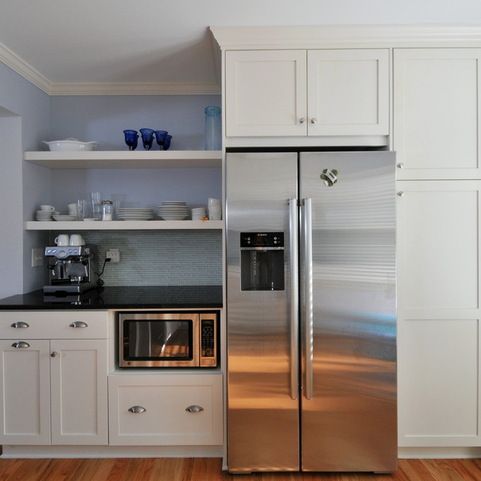ko9gan 237l Upright Fridge
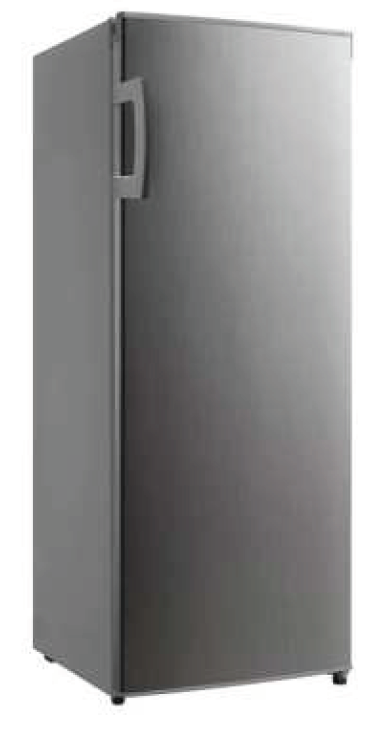

THIS USER GUIDE COVERS THE FOLLOWING MODELSKogan 237L Upright Fridge – Stainless Steel (KAM237UPSFA)Kogan 237L Upright Fridge – White (KAM237UPWFA)
SAFETY AND WARNINGS
Thank you for buying this Kogan product. Please read all safety instructions before using your fridge or freezer.
- Read this manual thoroughly before first use, even if you are familiar with this type of product. The safety precautions enclosed herein reduce the risk of fire, electric shock and injury when correctly adhered to.
- Make sure you understand all instructions and warnings.
- Always follow basic safety precautions and accident prevention measures when using an electrical appliance, including the following:
- IMPORTANT: Pay particular attention to messages that contain the words DANGER, WARNING or CAUTION. These words are used to alert you to a potential hazard that can seriously injure you and others. The instructions will tell you how to reduce the chance of injury and let you know what can happen if the instructions are not followed.
- The refrigerant isobutane (R600a) is contained within the refrigerant circuit of the appliance, a gas with a high level of environmental compatibility, which is nevertheless flammable. During transportation and installation of the appliance, ensure that none of the components of the refrigerant circuit become damaged.
- WARNING: Do not damage the refrigerant circuit. Never use an appliance with a damaged refrigerant circuit. If the refrigerant circuit becomes damaged, avoid proximity to openfires and all types of heat and ignition sources. Thoroughly ventilate the room in which the appliance is located.
- DANGER: It is hazardous for anyone other than an authorised service person to service this appliance. In Queensland, the authorised service person MUST hold a Gas Work Authorisation for hydrocarbon refrigerants to carry out servicing or repairs which involve the removal of covers.
Usage Conditions and Restrictions
- This appliance is only intended for use within a domestic environment only.
- If the supply cord is damaged, it must be replaced by Kogan.com or an authorised service agent on Kogan.com’s behalf.
- Do not store explosive substances such as aerosol cans with a flammable propellant in this appliance.
- The appliance must be unplugged after use and before carrying out user maintenance on the appliance.
- WARNING: Keep ventilation openings in the appliance enclosure or in the built-in structure clear of obstruction.
- WARNING: Do not use mechanical devices or other means to accelerate the defrosting process, other than those recommended by the manufacturer.
- WARNING: Do not damage the refrigerant circuit.
- WARNING: Do not use electrical appliances inside the food storage compartments of the appliance, unless they are of the type recommended by the manufacturer.
- WARNING: When positioning the appliance, ensure the power cord is not trapped or damaged.
- WARNING: Do not locate multiple portable socket-outlets or portable power supplies at the rear of the appliance.
- Do not use extension cords or ungrounded, (two prong adapters.
- This appliance is designed to be standing only and should not be recessed.
Electrical safety:
- Before connecting and turning on the appliance, ensure the electrical voltage and circuit frequency correspond to that indicated on the appliance rating label.
- This appliance should be properly earthed for your safety. The power cord of this appliance is equipped with a three-prong plug for use in standard wall outlets to minimize the possibility of electrical shock. Do not modify the cord and/or plug provided with the appliance. Improper use of the earthed plug can result in the risk of electric shock.
- This appliance requires a standard 220-240V AC 50Hz electrical outlet. Do not overload the electrical circuit.
- Do not kink or damage the power cord; do not leave it exposed or dangling. Secure it at the back of the appliance so no one steps on or places anything on the cord or against it. Keep the cord out of reach of children. When moving the appliance, make sure not to damage the power cord.
- Do not use an inverter, adaptor or extension cord with this appliance. If the cord is too short, have a qualified electrician install an outlet near the appliance. Use of an extension cord and an inverter can negatively affect the performance of the unit.
- To protect against the risk of electric shock, do not immerse the unit, cord or plug in water or spray it with any other liquid. Do not connect or disconnect the electric plug when your hands are wet. Turn the power switch off before removing the plug from the socket.
- WARNING: To reduce the risk of fire, electric shock or personal injury, always unplug the appliance from the socket when not in use, when moving and before cleaning or servicing. Never unplug the unit by pulling the power cord. Always grip the plug firmly and pull straight out from the power point.
Children:
- This appliance is not intended for use by persons (including children) with reduced physical, sensory or mental capabilities, or lack of experience and knowledge, unless they have been given supervision or instruction concerning use of the appliance by a person responsible for their safety.
- Children should be supervised to ensure that they do not play with the appliance.
Unpacking:
- During transportation, protective packaging was used to protect the appliance against any damage. After unpacking, please dispose of all elements of packaging in a way that will not cause damage to the environment.
- CAUTION: During unpacking, the packaging materials (polythene bags, polystyrene pieces, etc.) should be kept out of reach of children.
- This appliance is heavy, take care when moving it. To avoid back or other injury, consider a two person lift or mechanical aid when installing it.
- When unpacking, check the appliance carefully for damage. If it is damaged, do not install the appliance
Risk of Fire:
- If the refrigerant circuit should become damaged. Avoid open flames and sources of ignition. Disconnect the appliance from the mains power. Thoroughly ventilate the room in which the appliance is situated for several minutes.
Disposing:
- Old appliances should not simply be disposed of with normal household waste, but should be delivered to a collection and recycling centre for electric and electronic equipment. A symbol shown on the product, the instruction manual or the packaging shows that it is suitable for recycling.
- Materials used inside the appliance are recyclable and are labelled with information concerning this. By recycling materials or other parts from used devices you are making a significant contribution to the protection of our environment.
- Information on appropriate disposal centres for used devices can be provided by your local authority
PRODUCT OVERVIEW
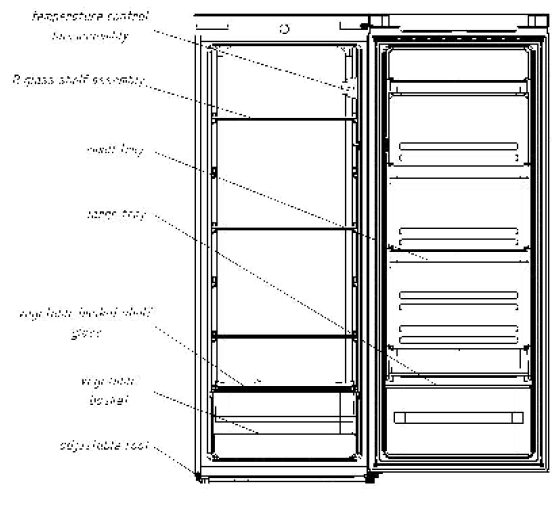

INSTALLATION
SELECTING A SUITABLE LOCATIONWhen selecting a position for your unit, ensure the floor is flat and firm, and the room is well ventilated. Avoid placing your unit near a heat source (ie, oven, radiator, or hot water system). Avoid direct sunlight as it may increase the electrical consumption. Extreme cold temperatures may also cause the unit to not perform correctly. This unit is not designed for use in a garage or outdoors. Do not drape the unit with any covering.When installing the unit, ensure that 10cm of free space is allowed to the left, right and rear of the unit, and 30cm at the top. This will allow cold air to circulate around the unit and improve the efficiency of the cooling process.
1a. Door space requirementsThe unit’s door must be able to open fully as pictured (1a).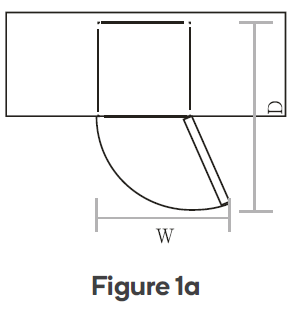

1b. Levelling the unitTo level the unit, adjust the two feet at the front of the unit – turning clockwise to extend and counter-clockwise to reduce. If the unit is not level, the door and magnetic seal alignments will not be covered properly, leading to inefficient freezing performance (1b). Ensure that the feet all touch the ground before use.
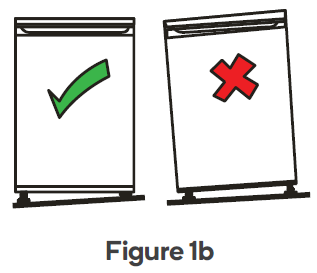

2. Reversing the door swing
TOOLS REQUIREDPhillips head screwdriver, flat-blade screwdriver, and hexagonal spanner.NOTE: Ensure unit is unplugged and empty.
a. Remove the top right hinge cover.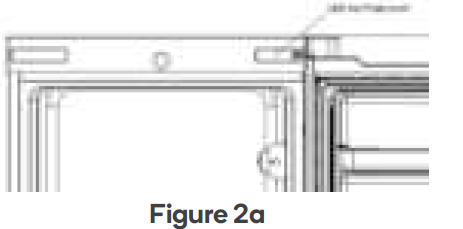

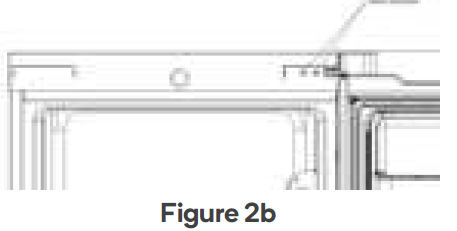

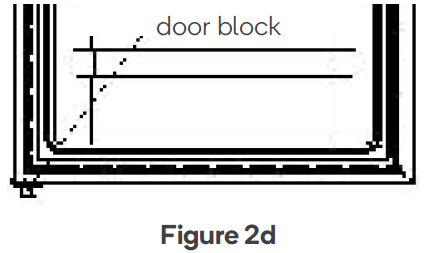







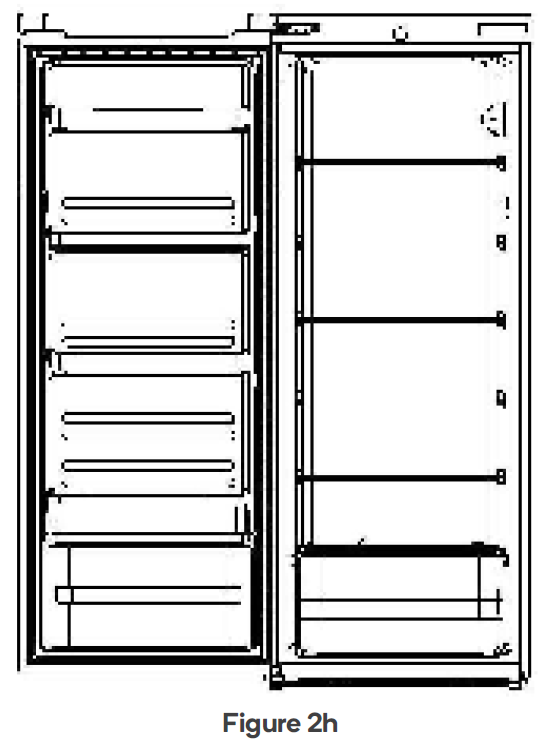



Door handle install (optional)
TOOLS REQUIRED: Phillips head screwdriver
- Remove the two plug pins from door’s opening side (3a).
- Place the door handle and fasten with the two M3x10mm screws, tightening with a Phillips head screwdriver (3b).
- Cover the screw heads with caps (3c).

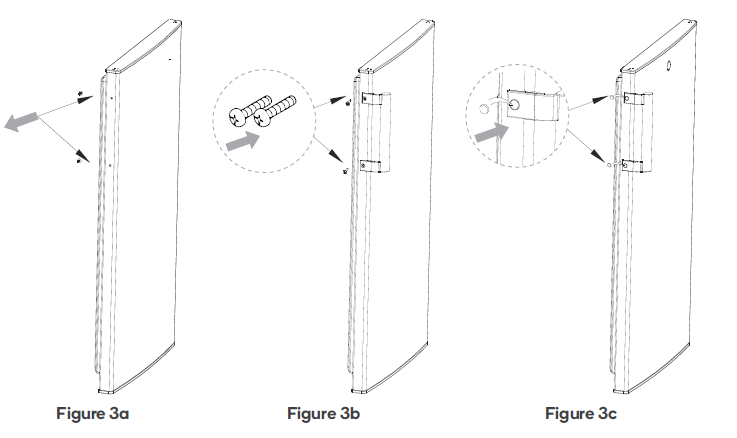
FIRST TIME USE
POWER SOURCE AND GROUNDING
It’s recommended to use the vertical fridge on its own dedicated power outlet for both convenience and safety. The power outlet must be grounded.Important! If the supply cord is damaged, it must be replaced by Kogan.com or an authorised service agent on Kogan.com’s behalf. Cease use and ensure the appliance is completely disconnected from the power supply.
Cleaning before use
Wipe the inside of the unit with a weak solution of bicarbonate soda, then rinse with warm water using a wrung-out cloth or sponge. Wash the shelves and drawers in warm soapy water and dry completely before replacing in the unit. Clean the exterior of the unit with a damp cloth. Further cleaning instructions can be found on page 13.
Before using your unit
- You must also wait at least two hours after moving the unit, before turning the appliance on.
- Do not use when the power cord is damaged or the plug is worn.
- Do not alter the power cord under any circumstances, so as to ensure safe use.
- Do not put flammable, explosive, volatile and highly corrosive items in the refrigerator to prevent damages to the product or fire accidents.
- Do not place flammable items near the refrigerator to avoid fires.
- This product is a household refrigerator and is only suitable for the storage of foods.
- According to national standards, household refrigerators shall not be used for other purposes, such as storage of blood, drugs or biological products.
- Before placing any food in your unit, turn it on and wait for 24 hours, to make sure it is working properly and to allow it time to fall to the correct temperature. Your unit should not be overfilled.
- Important! Before plugging in your fridge, you must check that you have a power outlet which is compatible with the plug supplied on the appliance lead.
Operation
- The temperature selector is located on the right hand sidewall of the refrigerator interior.
- Setting “Min” = Moderate cool temperature
- Setting “Mid” = Normal operation (suitable for most environments)
- Setting “Max”= Coolest temperature
- During high ambient temperature days (ie. hot summer days), it may be necessary to set the temperature to the coolest setting (“Max”). This may cause the compressor to run continuously in order to maintain a low temperature within the cabinet.
- For the first time you install your refrigerator, set the temperature at“Mid” and give your refrigerator time to cool down completely before adding food (normally up to 24 hours).
Noise from your fridge
- You may notice that your fridge makes some unusual noises. This is completely normal for refrigerators and freezers, and the noises are caused by the circulation of the refrigerant liquid within the cooling system.
Tips for keeping food within the fridge
- Cooked meats & fish should always be stored on a shelf above raw meat/fish to avoid bacterial transfer. Keep raw meat/fish in a container which is large enough to collect juices and cover properly, placing the container on to the lowest shelf.
- Leave space around your food to allow air to circulate inside the unit.
- Ensure all parts of the appliance are kept cool.
- To prevent transfer of flavours and drying out, pack or cover the food separately. Fruit and vegetables do not need to be wrapped.
- Always let pre-cooked food cool down before you place into the fridge. This will help to maintain the internal temperature of the fridge.
- To prevent cold air from escaping the fridge, try to limit the number of times you open the door.
CLEANING AND MAINTENANCE
WARNING! To avoid an electric shock, always unplug your fridge before cleaning.
Cleaning the inner cabinet
- Caution: Before using any cleaning products, please read and follow the manufacturer’s instructions and warnings to avoid any damage to your fridge or personal injury.
- Upon installation of your new appliance, it is recommended that it be cleaned thoroughly.
- Wash the inside with a damp warm cloth containing a water and baking soda solution.
- The solution should be about 2 tablespoons of baking soda to 2L of water.
- Wash the storage basket with a mild detergent solution.
- Be sure to keep the door seal clean to keep the unit running efficiently.
- The outside of the fridge should be cleaned with mild detergent and warm water.
- Dry the interior and exterior with a soft cloth.
- The condenser coils should be carefully vacuumed when they are dusty or dirty.
- It is recommended that the unit be cleaned each time it is defrosted to help keep the unit odour free and running efficiently.
- Clean your door gasket seals every 3 months using the same warm water solution described above.
Cleaning tips
- Condensation may appear on the outside of the unit. This may be due to a change in room temperature. Wipe of any moisture residue. If the problem continues, please contact a qualified technician for assistance.
Care When Handling / Moving Your Unit
- Hold the unit around its sides or base when moving it. Under no circumstances should it be lifted by holding the edges of the top surface.
Servicing
The unit should be serviced by an authorised engineer and only genuine spare parts should be used. Under no circumstances should you attempt to repair the unit yourself. Repairs carried out by inexperienced persons may cause injury or serious malfunction. Contact Kogan.com
Switching Of for Long Periods of Time
- When the unit is not in use for a long period of time, disconnect it from the mains supply, empty all food and clean the appliance, leaving the door ajar to prevent unpleasant smells.
Warm tips
- The refrigerator enclosure may emit heat during operation specially in summer, this is caused by the radiation of the condenser, and it is a normal phenomenon.
- Condensation phenomenon will be detected on the exterior surface and door seals of the refrigerator when the ambient humidity is large. This is a normal phenomenon, and the condensation can be wiped away with a dry towel.
- Buzz will be generated by running compressor specially when starting up or shutting down.
Tips for energy saving
- Try not to open the door too often, especially when the weather is wet and hot. Once you open the door, close it as soon as possible.
- Every now and then check if the appliance is sufficiently ventilated(adequate air circulation behind the appliance).
- In normal temperature conditions, please arrange the thermostat at the middle setting.
- Before loading the appliance with packages of fresh food, make sure they are cooled to ambient temperature.
- Ice and frost layer increase energy consumption, so clean the appliance as soon as the layer is 3-5 mm thick.
- If it is the outer condenser, the rear wall should be always clean free of dust or any impurities.
- The appliance should be located in the coolest area of the room, away from heat producing appliances or heating ducts, and out of the direct sunlight.
- Let hot foods cool to room temperature before placing in the appliance. Overloading the appliance forces the compressor to run longer. Foods that freeze too slowly may lose quality, or spoil.
- Be sure to wrap foods properly, and wipe containers dry before placing them in the appliance. This cuts down on frost build-up inside the appliance.
- Appliance storage bin should not be lined with aluminium foil, wax paper, or paper towel. Liners interfere with cold air circulation, making the appliance less efficient.
- Organise and label food to reduce door openings and extended searches. Remove as many items as needed at one time, and close the door as soon as possible.
Disposal
- Old units still have some residual value. An environmentally friendly method of disposal will ensure that valuable raw materials can be recovered and used again. The refrigerant used in your unit and insulation materials require special disposal procedures. Ensure that none of the pipes on the back of the unit are damaged prior to disposal. Up to date information concerning options of disposing of your old unit and packaging from the new one can be obtained from your local council office.
- When disposing of an old unit break of any old locks or latches and remove the door as a safeguard.
BASIC TROUBLESHOOTING
Fridge isn’t operating
- Check that the fridge is plugged in and connected to power.
- Check whether voltage is too low.
- Check that a fuse hasn’t blown or circuit tripped.
Fridge is making strange odour
- Odourous foods should be closely wrapped and sealed in containers.
- Ensure that the interior is clean. Refer to cleaning instructions.
Fridge compressor is continuously running
- It is normal for the fridge compressor to operate for longer periods of time when the ambient temperature is higher (ie. Summer).
- Do not put too much food in the fridge at one time.
- Do not put warm/hot foods into the fridge.
- Try to minimise the frequency of the door opening.
Illuminating light does not work
- Ensure the fridge is connected to power.
- Check that the globe hasn’t blown.
The fridge door doesn’t close properly
- Ensure that food isn’t preventing the door from closing.
- Ensure that the fridge is completely level and feet adjusted to touch the floor.
- Ensure the fridge door gaskets/seals are clean.
Water pan overflows
- Doors not closed properly, resulting increased defrosting.
- Too much food within the fridge, or stored food contains too much water, resulting in heavy defrosting.
The fridge is making loud noises
- It’s normal for the fridge to make noises when refrigerant coolant is being circulated.
- Check that the fridge is correctly levelled.
Need more information?We hope that this user guide has given you the assistance needed for a simple set-up.For the most up-to-date guide for your product,as well as any additional assistance you may require, head online at help.kogan.com


[xyz-ips snippet=”download-snippet”]

